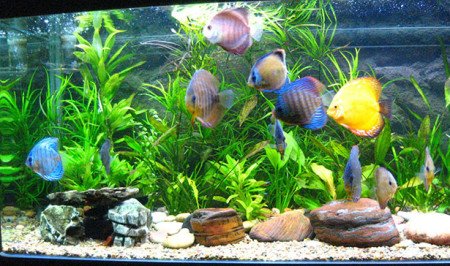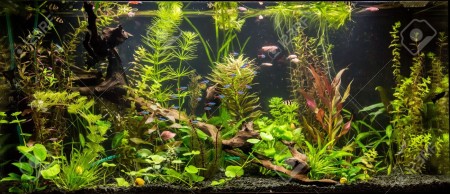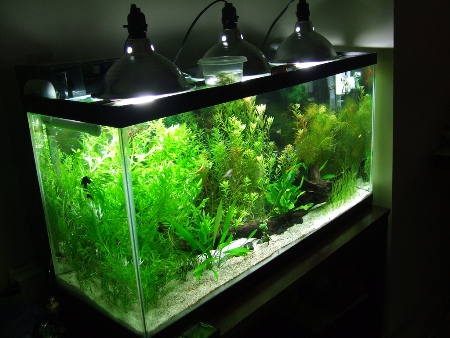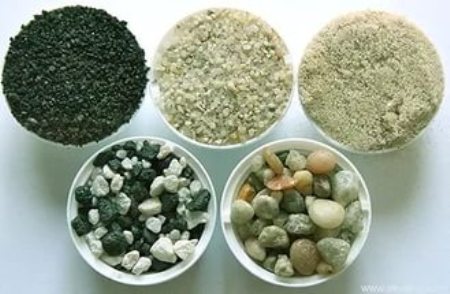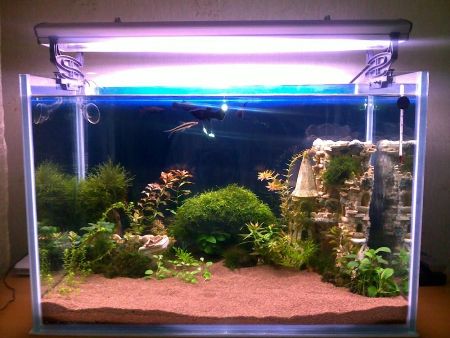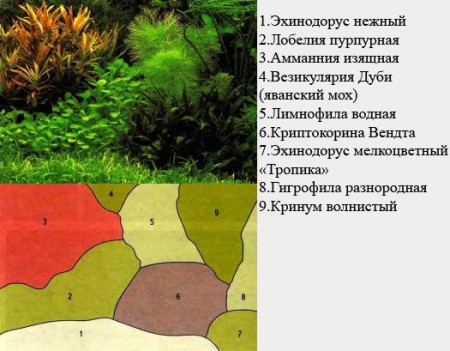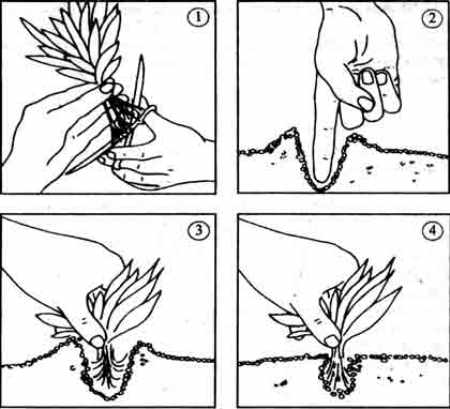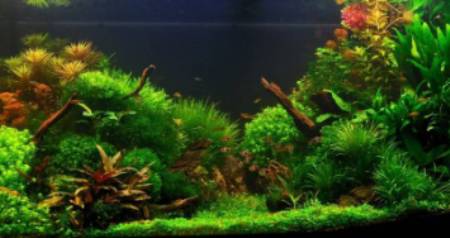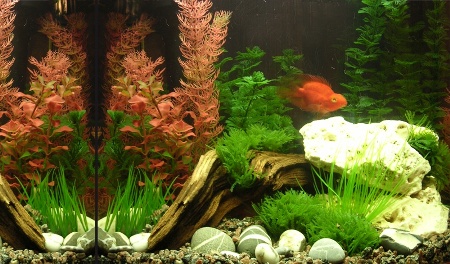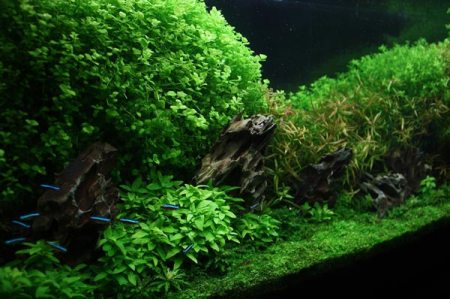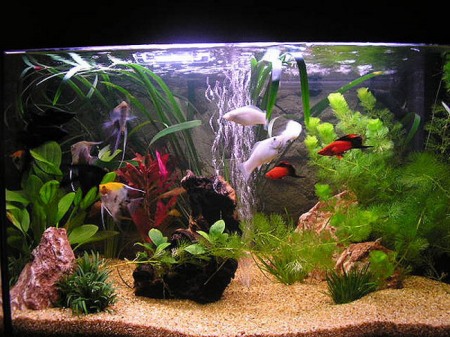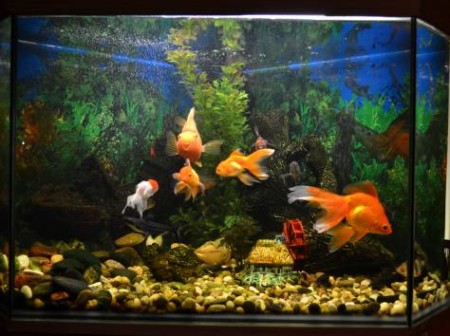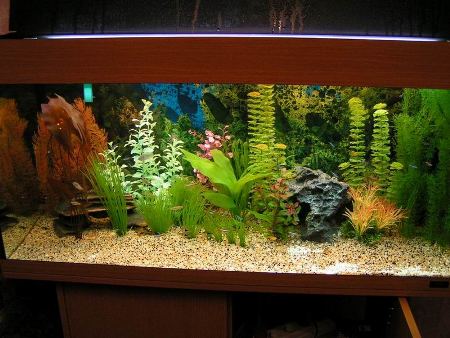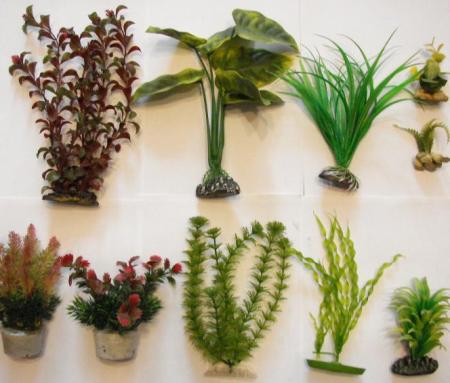To make the aquarium as attractive as possible, you need to take care not only of interesting fish, but also fill it with vegetation. Practice shows that plants for the aquarium should be chosen with skill, this process is sometimes quite difficult even for those who are fond of breeding indoor plants.
Let's try to understand the issue and decide what kinds of plants and in which cases it is desirable to give preference.
Content
- 1 Do you need plants in the aquarium, species of living plants for the aquarium
- 2 Illumination of aquarium for plants
- 3 Soil in the aquarium for plants and the basic requirements for it
- 4 Planting the plants in the aquarium
- 5 In which order is it best to plant the plants in the aquarium
- 6 Do not grow plants in the aquarium - what's the reason?
- 7 Artificial Plants for the Aquarium
Do you need plants in the aquarium, species of living plants for the aquarium
Plants - not only a decorative element, in an aquarium they:
- serve to enrich the water with oxygen,
- act as a natural water filter,
- absorb carbon dioxide,
- contribute to the maintenance of biochemical processes in water, which maximizes the conditions to an ideal,
- create natural thickets that allow them to hide themselves in fry and small fishes, are the source of building materials during spawning,
- are used by fish as a green food.
When calculating the number of plants for a certain capacity, it is necessary to take into account not only its dimensions, but also the population of fish and the requirements for the level of illumination. To ensure that the plants themselves have an attractive appearance and multiply well, they need to maintain a certain level of acidity, stiffness and temperature in the water.
Therefore, before selecting plants, you should carefully study the characteristics of the contents of the fish, which will be populated by the aquarium. The entire green world of the aquarium is divided into several groups. The largest of these is underwater plants, then - floating, and finally - above-water.
When buying plants in the store, you should pay attention to their general condition, the absence of stains on the stems and damage to the leaves, it is desirable that they were young. If plants are slow growing, then it's easiest to get older adults.
In order to obtain an attractive aquarium, it is necessary to select plants of different groups and species for it, their combination will create the illusion of naturalness, fish such a diverse environment of existence will also have to taste.
Experts do not recommend too clutter up the space of the aquarium - even small and calm fish will need a place for free swimming. Useful advice: creating a beautiful composition will be easier from a large number of plants of several species than from a small number of plants of a variety of varieties.
About live plants for an aquarium - on video:
Illumination of aquarium for plants
When buying plants, you should also consider that each of their kind has different requirements for lighting. The lack of natural light can cause a slowdown in growth, and in some cases even the death of plants. The following plants are rather demanding for light: ludwigia, cryptocoryns, bakops, cardamins, marsilia, water ferns. As for the organization of lighting, it is necessary to know that it is important for plants and for fish.
But overabundance of light can cause too active development of algae and flowering water in the aquarium.
If the vegetation in the aquarium mixed duration of the period of illumination can be up to 12 hours a day. If there is a need for increased plant growth, the duration of the illumination is increased. But it should be remembered that abrupt changes in the duration of a daylight, too long a period of illumination or vice versa, too short, can cause stress and cause plant diseases.
Excessive lighting can harm fish - they will hide from the light, their color may lose brightness. Most often problems with illumination arise in aquariums of non-standard dimensions, the height of which exceeds 0.38 m.
To ensure that the light from the lamp does not cause a stressful condition in the fish and is sufficient for the normal development of plants, it is recommended to use a lamp commensurate in length with the aquarium. This option is considered optimal in the event that the depth of the reservoir is small.
If the plants require more intensive lighting, then for the aquarium it is better to choose fish that are the inhabitants of small water bodies - they are not afraid of bright light. If the fish are deep-sea fish, then plants should be chosen such that they can develop in dim light.
Soil in the aquarium for plants and the basic requirements for it
Soil for plants should also be chosen carefully, because it will serve as a background for moving fish, i.e. the important point is its color. In addition, the soil is the environment responsible for maintaining the biological balance, because it processes the waste of feed, fish excrement, falling leaves.
The soil contains bacteria that promote the decomposition of organic matter and provide bio-purification. Beginners aquarists are interested in the question of where to get the soil. It can be found in the channels of natural reservoirs, but before placing such a primer in an aquarium, it will take several procedures to process it.
Therefore, the easiest way is to buy the soil in finished form. It should be remembered that the composition of the soil is a very important point. For example, limestone soil will release carbonates into the water, this will significantly increase the hardness of the liquid, as a result, some species of fish and plants may suffer. Check whether the carbonate is easily contained in the ground, it is enough to drop vinegar on it, if there is a reaction, bubbles begin to appear.
The quality of soil for aquariums can be divided into subgroups: created artificially, natural gravel, pebbles, gravel, obtained by processing natural materials.
Details about the soils for aquariums and much more useful information - on the video:
Planting the plants in the aquarium
The plants purchased for planting will need to be prepared, i.e. remove from them fragments of filamentous algae, eggs of snails, rotten patches. It will not be superfluous to disinfect with a one-percentage solution of alum or a 2% solution of manganese. The plants are immersed in the solution for 10-15 minutes, then thoroughly washed in running water.
Roots are cut off, their length should correspond to the thickness of the soil layer. To place plants when planting too close is not recommended, because some of their varieties grow extremely quickly. For example, the plant planting scheme can be as follows:
The soil should be such that it does not attack the roots of the plants with a strong squeezing. Plants are placed in it in such a way that the roots are completely covered with soil, the growth bud must remain on the surface.
The supply of nutrients comes directly from the water, with the help of leaves. Optimum variant - landing of creeping plants - on some stems together, in the form of bushes. If the task is to get the effect of a solid green wall in front view - it will be necessary to plant the plants in a checkerboard pattern. Often resorted to planting plants not in the ground, but in pots.
This option should be used if the fish like to dig in the ground, or whether control over the activity of plant growth is required. As an advantage of the potting method of planting, it is necessary to note the possibility of extracting the plant from water without damaging the roots, with the further return of the plant back into the water.
In which order is it best to plant the plants in the aquarium
That plants do not interfere with the review of the aquarium and create convenience for fish, when they are planted, one should adhere to certain rules. For example, larger varieties with a dense crown should be placed in the background, provided that the light source is above the aquarium.
Accordingly, smaller ones are desirably located in the central part of the container or along the side walls. Beautifully growing shrub plants should be placed apart, this will give an opportunity to admire the beauty of each of them. The front part of the tank can be decorated with small-sized species, they will not cover the entire water area and allow them to observe the life of the fish.
If the illumination of the aquarium is not the same, it is advisable to plant plants that are fast growing and blooming closer to light. In addition, the plants in the aquarium, the species that were chosen for planting, should be broken up into groups, the groups can be divided using koryaks or pebbles.
The dirt can be decorated with different types of moss, its roots can be placed in small cracks found on wood. If the acquired plants belong to different species, then it is recommended to fill the aquarium in the following sequence:
- first of all planted growing in the ground,
- further - floating in the water,
- at the last stage - living on the surface.
You can fill the tank with water after planting the ground plants. During the operation of the aquarium, constant monitoring of the plants will be required, with their strong growth it is recommended to remove a part of the shoots, the representatives of the flora remaining on the surface of the water should not overlap the light to those that grow on the bottom. Any broken twig or withered leaf is required to be removed immediately.
Replacement of water in the body of water should be done once a week, in the amount of about 10% of its total quantity. How many plants should be planted in an aquarium As with any other question, it will be necessary to adhere to a reasonable ratio of the number of fish and plants.
And if there is a lot of plants for each fish, the water in the aquarium will always remain clean: particles of fish waste will decompose under the influence of bacteria and serve as an excellent source of nutrition for the roots of plants. If the fish will be too much to achieve biological balance will not succeed.
However, it is not recommended that plants occupy more than a third of the area in the aquarium. The problem is that if oxygen is released in the daytime by vegetation, then in the night - oxygen with the same activity will be absorbed by the plants, the fish can suffer from oxygen starvation.
Do not grow plants in the aquarium - what's the reason?
The answer to the question is obvious - you could not create suitable conditions for their growth. The reason can be even a very large number of fish. An important condition is insufficiently intensive lighting and short duration of daylight hours. To improve the growth, you will also need to fill the aquarium with clean water.
It is important to give the fish a sufficient, but not excessive amount of food, otherwise its residues will be oxidized and poison the water with ammonia. The reason for the slow development of plants can be the salts of heavy metals present in the water.
The optimal option - conducting periodic measurements for the determination of: the presence of toxic substances, the rigidity of the liquid, acidity, the level of saturation with oxygen and carbon dioxide. Ideal are the pH-neutral medium and the average water hardness.
Artificial Plants for the Aquarium
When planting the aquarium, you can use not only living, but also artificial plants. They look pretty attractive, they can also serve as a shelter for small fish.
As advantages, it should also be noted:
- simplicity of care for artificial thickets,
- they do not require additional dressings, transplants,
- they can not deteriorate leaves,
- to clean them from plaque is very simple.
Use artificial plants in the aquarium is definitely possible, but you will need to make sure that they are made of quality environmentally friendly material and their presence in the water will not cause any harm to the fish. An attractive species such plants retain for a long time, and their diversity will make up a fairly original composition.
Especially useful is the option of using artificial vegetation for those owners of aquariums that do not have enough time to care for plants.
In appearance, artificial plants differ little from living animals, and even they are their polymeric copy, it is very difficult to distinguish them visually from real ones. A rich range of shades and forms of artificial vegetation will create an attractive aquarium design.
When buying polymer products, you should make sure that the material does not have a strong unpleasant odor. Before immersion in water plants are washed in running cold, then hot water, do not use chemical agents. You can conduct additional testing - put the purchased plants in a container with a solution of whiteness.
At the same time, quality products will not change their color and will not stain water. But no matter how beautiful and practical the artificial plants are, the optimal variant of aquarium design can be considered a combined one, combining living plants and artificial ones.
So an unequivocal answer to the question which plants are best for the aquarium is not, everything depends on the specific conditions, but it is best to give preference to the combined variant from living and artificial plants.
On how to make a beautiful aquarium with your own hands - on the video:



